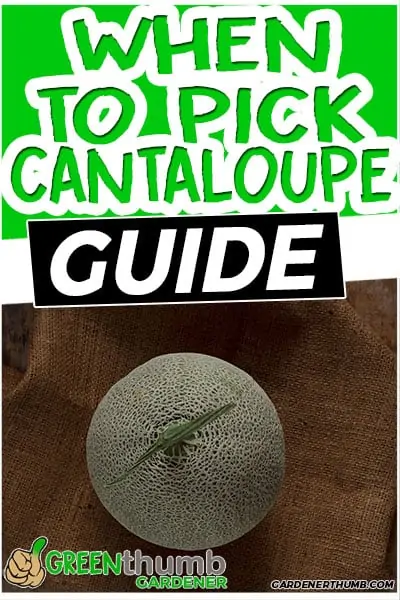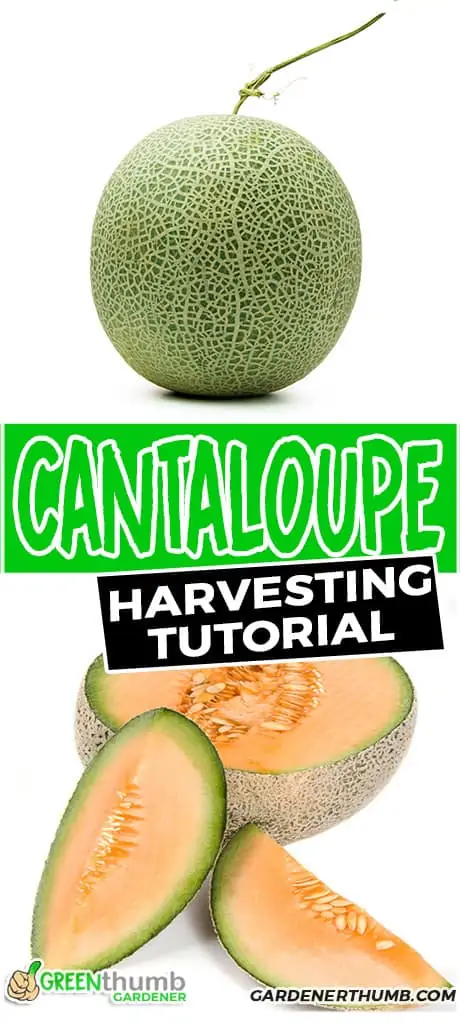When To Pick Cantaloupe From The Vine
Last updated: 03/26/21
A ripe, juicy, sweet cantaloupe on a hot summer day is so refreshing, but at first you might be worrying about knowing when to harvest them from your garden.
You don’t want to pick too early and lose out on good flavor, or miss the window and end up with an overripe, mushy cantaloupe.
Green thumb Gardener occasionally links to product and/or services offered by vendors to assist you with all your gardening needs. Some of these may be affiliate links, meaning we earn a small commission if items are purchased.
Want to Download a Garden Hack Guide for FREE

Enter your email below and we will send you a guide to help you SAVE money in your garden.
When to Harvest Cantaloupe
Depending on the variety, the weather, and how fertile the soil is, the best time to pick them will likely happen about 12 weeks after the seed germinates, and usually about a month to 7 weeks after the vine produces flowers.
What to Look For
You can also look at the vine where the melon connects, and if the stem appears to be cracking or detaching, it may be done with the ripening process.
Cantaloupes appear smooth when they are younger, and the netting, a spiderweb-like or striped pattern, will appear gradually on the surface as it matures.
When a cantaloupe’s netting becomes an opaque, creamy color and the rind turns from green to tan or golden color between the netting, it is time to harvest.
You may also smell a sweet scent around the melon, especially the blossom end (the opposite end from where the vine is attached to the stem), which is a sure sign it’s ready to pick.

This scent may also be musky, which is why cantaloupes are also known as muskmelons.
True cantaloupe are not commonly found in the United States, but the varieties we grow as just as good as true cantaloupe.
Ground Spotting Technique
You might also want to use the ground spot technique: gently lift it from the soil and see if it feels heavy for its size. If it does, that’s a good sign that it may be ready to be picked.
If your cantaloupe is resting on the ground while growing, it may develop a smooth yellow ground spot where it touches the ground. This yellow ground spot develops as the fruit ripens, so that can be another clue that your fruit is ripe.
Your cantaloupe should feel firm to the touch, but not hard. If it feels like a rock, it’s probably not ripe yet. It also should not have any soft or spongy spots, which can be an indication of rot.
If you gently tap the melon, a ripe one will sound low and solid, not hollow. The blossom end may feel like it has a little of give when you press gently on it.
Ripe Cantaloupe vs. Unripe
Ripe cantaloupes have a firm but still supple texture. Allowing this type of melon to ripen on the vine assures that it will have the sweetest possible taste.
I’ve noticed that I get better flavor growing in my own gardens than I do when buying in a supermarket, because mass-produced cantaloupes are generally harvested before they’re ripe.
Once a cantaloupe is picked it has reached peak of flavor and it is unlikely to get any sweeter.
As you watch your locally grown, vine-ripened melons grow every day, you may find it easier to recognize the changes they go through as they reach maturity.
How to Harvest Cantaloupe
Like other melons including watermelons and honeydew, ripe cantaloupes will come off the vine easily, without much effort at all. The ease of harvesting is high!
If you have to pull, it may not be done ripening. If it has that golden color and you’re certain it’s ripe but you have difficulty in harvesting, you can cut the stem carefully with a pruning knife.
Generally speaking, though, if you press gently on the vine, you should feel the cantaloupe pull away easily.
Regardless of the method I choose during cantaloupe harvest season, I always treat the cantaloupe with care and a gentle touch to avoid damaging the fruit or the vine.

If damaged, the vine can be susceptible to disease or pests. It is also best to harvest cantaloupe when the plant is dry, as harvesting when it is wet can also make the vine vulnerable.
The sweet scent of the melon will likely be strongest in the afternoon sun, so later in the day is ideal harvesting time.
Cantaloupe Storage & Seed Saving Tips
Cantaloupe is best when eaten within a day or two of harvest. Sometimes I’m not able to cut it open and enjoy it right away, so then I store it whole in the refrigerator.
To keep it fresh, I wait to wash it until I’m ready to cut into it. When I’m ready to cut into a cantaloupe, I make sure to wash the rind, thoroughly scrubbing the outside of the fruit with warm water and a stiff bristle brush.
You may wish to store your chunks of melon in an airtight container in the refrigerator, where it will keep for several days.
To freeze cantaloupe, cut into pieces and store in an airtight container and it should keep in the freezer for several months, possibly up to a year.
Whenever you cut into your cantaloupe, be sure to save the seeds!
This is especially important if you enjoyed a perfect melon. You want to be able to grow more of them next year!

Further Reading
Cantaloupe Seed Saving Tips
When saving cantaloupe seeds keep these in mind after the initial ripening stages:
- Track – Keep track of their progress, so you can establish a timeline for how they grow in my conditions.
- Ripen Experience – Use this information next year, so you can look for that golden color and have a very good idea of when my cantaloupes can be expected to ripen.
- Open-Pollination – Cantaloupes are open pollinated, meaning they can cross-pollinate with other melons, so always make sure to only plant one type in your garden any given year. This is to ensure your cantaloupe seeds are guaranteed to be true to that variety.
Steps To Save Melon Seeds
To save the cantaloupe seeds, follow these steps:
- Scoop out the seed masses when you cut the cantaloupe open
- Set aside the seed pulp in a glass jar with some warm water
- Let them sit for a few days, stirring once a day.
- Viable cantaloupe seeds will sink to the bottom of the jar and any non-viable seeds will float to the surface
- Pour off the water and discard that along with the non-viable seeds and any bits of melon
- Wash the viable seeds in a strainer and wash them clean
- Spread them out on a screen or paper towel. The key to saving seeds is to let them dry thoroughly before storing, and this usually takes several days.
You can store seeds in a glass jar, but some gardeners prefer a paper seed packet. Just be sure to label it so you remember what it is come planting time!
Final Thoughts
Learning the process of cantaloupes and when to harvest is just a matter of paying attention to the way the melon changes as it matures.
Once you know the cycle of cantaloupes, you’ll be enjoying juicy, quality cantaloupe along with the satisfaction that you grew it yourself!
Related Questions
Will a cantaloupe ripen off the vine?
A cantaloupe that has been harvested but not cut into may continue to ripen off the vine, but it will not get any sweeter.
How do you sweeten an unripe cantaloupe?
One cannot cause a harvested, unripe cantaloupe to sweeten, but one could use sugar or other sweetener to improve the taste of an unripe melon. Unripe cantaloupes can also be used as an ingredient in savory dishes.








